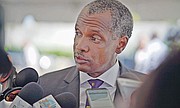By NEIL HARTNELL
Tribune Business Editor
nhartnell@tribunemedia.net
More than 50 percent of the $92m owed by customers to Bahamas Power & Light (BPL) at-end October 2018 represented arrears owed from previous monthly billing periods.
Data tabled in the House of Assembly yesterday by Desmond Bannister, minister of works, revealed that $48.415m or 52.7 percent of BPL’s total $91.797m receivable dated from previous months.
Of the arrears, around one-third or some $16.068m would be described as non-performing, given that this sum is more than 90 days or three months past due, highlighting the severe cash flow difficulties experienced by BPL as a result of customers failing to pay due bills on time.
“It’s a huge impact,” Mr Bannister told Tribune Business. “People don’t understand the kind of receivables BPL carries, and that’s why they have to collect charges in a prompt manner.
“It affects the efficiency of the company. The company is already saddled by legacy debt of close to $500m, and so it has to collect on a regular basis.”
Just 79 BPL customers were responsible for almost 25 percent, or one-quarter, of BPL’s receivables, as their combined debts of $50,000 or higher stood at $22.909m - with around half of this sum representing arrears from previous periods.
The statistics highlight how The Bahamas’ energy crisis cuts both ways, with consumers struggling with escalating costs driven by high global oil prices that have been exacerbated by BPL’s forced reliance on more expensive fuel sources due to the recent Clifton Pier fires that knocked out its most efficient generation units.
In turn, BPL’s high accounts receivables deprive it of essential cash flow, leaving it struggling to pay its bills, fuel suppliers and finance essential maintenance and upgrades across both its generation and transmission and distribution infrastructure.
All this results in a vicious circle of high energy costs and power outages, with BPL also absorbing increasing costs through the Government’s decision to increase the VAT exemption threshold from $200 to $300 monthly power bills.
And the state-owned energy monopoly has also “capped” its fuel charge at 19.15 cents per kilowatt hour (KWh), meaning that it has not passed on all such costs as is its traditional practice.
Whitney Heastie, BPL’s chief executive, in a November 27 email to Mr Bannister, said December’s fuel charge will be 21.676 cents per KWh, based on a $33.916m fuel burn cost and 156.467 KW hours of power generated.
“Therefore, the fuel charge for December is 21 cents,” Mr Heastie wrote. “However, since the last increase in fuel charges we have not been passing on the full amount. So the last couple of months we have capped the charge at 19.15 cents.”
Despite this, 5.412 BPL customers owing a total $5.393m remain disconnected by the utility, including 4,639 on New Providence. Mr Bannister yesterday said the number typically fluctuated between 4,500 to 6,500, a statistic that has changed little since the 2008-2009 recession.
The data supplied in the House of Assembly yesterday suggested between 11,000 to 15,000 BPL customers will benefit from the VAT exemption threshold increase. However, this likely represents a modest bit of good news, as those paying at the $300 limit will only be saving $36 per month or $432 per year.
Mr Bannister, meanwhile, told Tribune Business that refinancing of BPL’s legacy debts, pension fund deficit and environmental liabilities via the proposed Rate Reduction Bond (RRB) is key to the utility’s very survival.
“There are some discussions on where we are going to go with that,” he told Tribune Business. “It’s critical for BPL, just too critical to the very existence of BPL.”
The former Christie administration’s refinancing plan involved issuing the RRB bonds, via a special purpose vehicle (SPV), to Bahamian and international capital markets investors. The proceeds would take out BPL’s legacy debts while keeping the new financing off the utility’s and government’s balance sheets, enabling the former to raise new capital to invest in badly-needed network upgrades.
The Minnis administration initially seemed reluctant to adopt the long-term financial restructuring tool left behind by its Christie predecessor, but the RRB’s placing is critical to raising the nine-figure sum required to restructure its legacy debt. It will add an additional charge to consumers’ electricity bills, representing monies that will be used to pay interest to investors in the RRB, but this will be a small component of the overall bill.





Comments
Chucky 5 years, 4 months ago
Why didn't they just cut off the 79 customers who are responsible for the 22mil in debt, rather than the 5400 civilian bills.
Clearly it's because they can't cut off der friends the businessman,
These people making the decisions and the frikin A holes who support it aught to be strung up, getting tired of these people picking on the poor and covering for the rich.
sheeprunner12 5 years, 4 months ago
Who are these 79 customers????? ........ Ministries??? ....... Hotels??? ..... PEPs?????? ........... They should have been named in the House.
bcitizen 5 years, 4 months ago
Why cannot these 79 companies be named? This is a public corporation. This should be readily accessible information!
Well_mudda_take_sic 5 years, 4 months ago
The lion's share of BPL's old customer account balances totaling many millions of dollars is owed by government enterprises and Baha Mar. But Bannister will never admit to that fact which is the very reason why he's such a lousy cabinet minister.....always meddling and putting his cronies in high paid positions where they do not belong.
Sign in to comment
Or login with:
OpenID